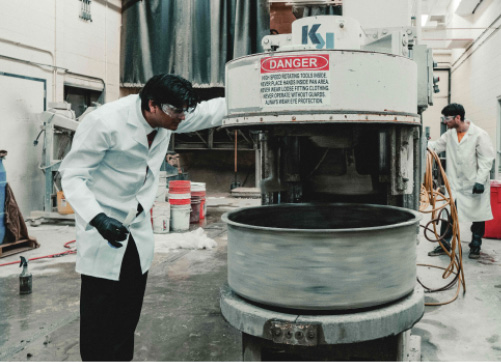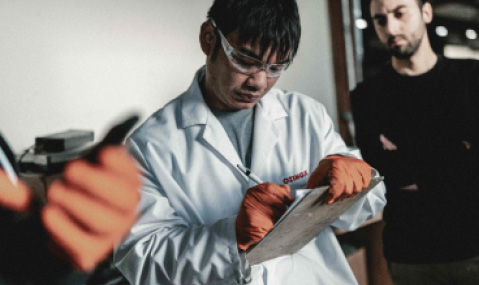Ozinga Ready Mix Concrete proves ideal partner as Facebook operator applies artificial intelligence to low-carbon mix designs
The spotlight on buildings’ life cycle carbon dioxide emissions is driving recognition of Environmental Product Declaration-defined Product, Construction Process, Use and End-of-Life Stage benchmarks.
After methodically lowering the Use Stage CO2 factor for its 14 operational, energy-intensive data centers in North America, Silicon Valley tech giant and Facebook operator Meta Platforms Inc. is zeroing in on Product Stage carbon.
“We are turning attention to our ambitious goal to achieve net zero emissions across our value chain by the end of 2030,” according to Meta Research Scientist Julius Kusuma. “This commitment includes addressing the indirect environmental impacts of our business, such as from the embodied carbon found in our buildings. Embodied carbon includes the upstream and downstream emissions from the manufacturing, transportation, maintenance, replacement, and decommissioning of building materials.”
“We start by analyzing life cycle impact in data center construction,” adds Meta Sustainability Program Manager Amruta Sudhalkar, who teamed with Kusuma to co-author “Green concrete: Using Artificial
Intelligence (AI) to reduce concrete’s carbon footprint,” an April 2022 dispatch. “Concrete bubbles to the top as one of the main sources of carbon emissions. To address emissions intensity, we look at how much concrete a project requires and for what application, along with technical performance requirements, and consider a workable low-carbon model.”
FIELD PROOF
The company’s biggest test of AI-informed carbon reduction in concrete specifications has entailed work on two non-critical structures— the construction personnel office space and guardhouse—at its DeKalb, Ill. data center. The principal sustainability performance focus is the mixes’ global warming potential (GWP), an EPD Product Stage metric expressed as CO2e kg/m3 (e = equivalent). Instead of merely reviewing GWP levels from candidate mix designs submitted by Ozinga Ready Mix Concrete, the Meta Physical Modeling, Data Center Design, Engineering, & Construction, and Sustainability teams are working with data science colleagues to usher AI and machine learning (ML) concepts into concrete design and project procurement.
They enlisted University of Illinois Urbana-Champaign (UIUC) Department of Electrical and Computer Engineering Professor Lav Varshney and Department of Civil and Environmental Engineering Professor Nishant Garg to assist in a low-carbon concrete AI model, premiering with the DeKalb project. The UIUC team used the University of California, Irvine Concrete Compressive Strength data set developed from 1,030 mix designs and test results, coupled with the Cement Sustainability Initiative EPD tool, to “train” the model to factor such criteria as individual materials; strength development at standard intervals; actual versus design strengths upon final cylinder tests; and GWP or other environmental criteria based on the CSI EPD metrics.
“AI can be used to learn and optimize for specific outcomes within high dimensional spaces, where data sets with many attributes can be modeled. When a valid data set is available, AI can be used to estimate or ‘learn’ the feasible high-dimensional space in terms of relevant parameters, such as strength and sustainability,” note Kusuma and Sudhalkar in “Green concrete.”
Researchers assisting the Meta Platforms DeKalb Data Center concrete schedule vet a database of mix designs and performance characteristics.
The mix designs train an artificial intelligence model (opposite page), which in turn generates new concrete formulations for testing and slump measurement at the University of Illinois Urbana-Champaign lab. The first AI-generated mix designs evolved to versions approved for two DeKalb slab pours (page 47).
The first AI model output influencing the DeKalb data center concrete schedule involved five mix designs with 28-day strength targets. Ozinga RMC refined them based on its expertise as a 94-year old industry practitioner; local material availability; and, predicted strength development under the cold weather conditions anticipated at the north-central Illinois site during Q1 2022 pours. One mix with an air-entraining agent and a second one without were used on 40,000 square feet of concrete slabs for a guardhouse and construction management team office. Tests confirmed that the concrete exceeded 7- and 28-day strength requirements, while exhibiting a carbon impact 40 percent lower than the regional slab mix benchmark.

VARIATIONAL AUTOENCODER MACHINE LEARNING MODEL
Meta Platforms demonstrates its open technology development philosophy in “Accelerated Design and Deployment of Low-Carbon Concrete for Data Centers.” The paper outlines the artificial intelligence (AI) and machine learning (ML) components attending construction of the company’s DeKalb, Ill. operation. It was presented in late June at ACM COMPASS 2022, Seattle, billed as an international forum for original research presentations supporting “the growth of sustainable societies.”
The authors discuss the (above-noted) UIUC Concrete Compressive Strength data-trained AI model development; DeKalb data center concrete schedule; and functionality of variational autoencoders (CVAE)—ML models yielding concrete mix designs with desired properties. “Such models directly generate new concrete formulations and make the best use of training data,” they contend. “CVAEs can design concrete formulas with lower emissions and natural resource usage while meeting design requirements, computationally and also in laboratory and field experiments. In the computational phase before experimental testing, we train models to predict the environmental impacts and strength of generated formulas. This provides initial insight to civil engineers in creating formulas that meet structural needs and best addresses local environmental concerns.”
The authors cite the time considerations attending traditional approaches to concretes suiting multiple attributes, noting, “Technical performance has traditionally been prioritized in the industry, and there is a general perception that optimizing for sustainability may adversely impact performance. With AI, we were able to accelerate the discovery process and validate good formulas within weeks. The low-carbon concrete formulas generated by the model entailed significant replacement of cement (upwards of 70 percent by weight) with a combination of fly ash and slag.”
“Accelerated Design and Deployment” was co-authored by Meta Platforms Research Scientist Julius Kusuma and Sustainability Program Manager Amruta Sudhalkar, Ozinga Ready Mix Concrete Vice President of Innovation and Market Development Ryan Cialdella, and researchers working at the UIUC Departments of Civil and Environmental Engineering and Electrical and Computing Engineering.
“We attained favorable results in the DeKalb AI model application, but need to better account for variability in site conditions and available materials before generally saying we have implemented low carbon concrete procurement,” Sudhalkar affirms. “We are taking lessons from our DeKalb project and trying to scale up mix evaluation mechanisms, and account for regional differences in concrete materials.”
DeKalb data slab pour data will help programmers improve the low carbon concrete AI effort, adds Kusuma. “The UIUC concrete mix designs for training the model were validated under lab conditions,” he says. “We need more data that are representative of actual field conditions, for example we need strength curves for relevant temperature ranges, especially at lower temperatures where curing speed is expected to be slower. The model needs to optimize mix designs for different site conditions.”
The CSI EPD tool assisted in the model training, but the AI programming effort—where reams of data points improve output—will evolve with mix-specific EPDs from producers like Ozinga RMC. “EPDs for individual plants and mixes have been valuable for preparing the model to assist with future concrete projects,” notes Kusuma. “Product-specific EPDs allow us to compare mix designs and their carbon intensities against mixes designed with portland cement only.”
MODEL PRODUCERS
Meta officials offered a data center construction progress update and low carbon concrete AI model introduction at a spring media briefing. Ozinga RMC Vice President of Innovation and Market Development Ryan Cialdella reflected on the productive aspects behind his company’s early participation in the concrete schedule planning and model launch. He explained how the circumstances involving Ozinga RMC and UIUC researchers “enabled us to work on this project starting with the end user down to the general contractors and concrete contractors, come together to tweak the proposed mixes from
UIUC’s AI model, and receive buy-in from all the stakeholders. We can continue to use the field data, feed it back through the AI model, and refine it to push the boundaries on carbon reduction.”
Experience at the DeKalb site with Ozinga RMC aligns with procurement philosophy and teamwork Tom Furlong, vice president, Infrastructure at Meta frames in “10 Years of Building World-Class Data Centers,” a late-2021 commentary. “There is a lot of activity in the data center and construction industries today, which puts pressure on us to find the right partners [and] create more flexible construction
processes. This involves looking at our vendors and contractors more as partners. We can’t just make this about dollars. We have to make it about performance, driving best practices and continuous improvement.”
AI model development assistance, test mix success, and timely concrete schedule execution suggest Ozinga RMC fits Furlong’s mold. “The collaboration between the Meta team, UIUC and our research and development laboratory is a testament to the realities we’ve created that leave a greener footprint for generations to come,” affirms President Justin Ozinga.







